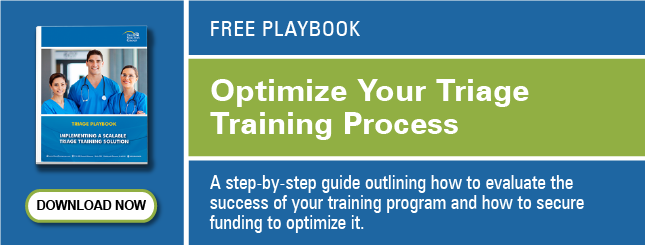 Over the last few years, many of our clients have expressed interest in demonstrating the impact that various system-wide performance improvement initiatives might have on patient outcomes or financial metrics. One of our colleagues from a large hospital system recently posed a similar question about triage. Like many initiatives, given there are so many variables in play, it is extremely difficult to pinpoint a cause and effect with triage; however, let’s explore four areas in which you could expect to see improvements with an efficient, safe triage process.
Over the last few years, many of our clients have expressed interest in demonstrating the impact that various system-wide performance improvement initiatives might have on patient outcomes or financial metrics. One of our colleagues from a large hospital system recently posed a similar question about triage. Like many initiatives, given there are so many variables in play, it is extremely difficult to pinpoint a cause and effect with triage; however, let’s explore four areas in which you could expect to see improvements with an efficient, safe triage process.
1) Productivity Metrics
Given the current climate in healthcare with value-based reimbursement and EHR implementations, productivity has become an even higher priority for EDs to ensure they remain financially stable. Having an expert triage nurse can impact the LWOBS, door-to-doc time, and other important metrics that are often measured by EDs. More importantly, they can more rapidly identify the high-risk patients that need to be seen immediately and protect the facility against adverse events and potential EMTALA violations.
2) Liability Exposure
When analyzing a diagnosis-related medical malpractice claim, you can often trace the error to a poor clinical decision in the triage process or lack of triage competency. For example, one case that we often highlight pertains to a delay in diagnosis in a 14-year-old male patient who presented to an ED with acute onset of scrotal pain. The triage nurse did not recognize the importance of this patient presentation and had the teenager and his mom wait in the ED for 4 hours. After significant frustration, the mother took her son to a different ED where the triage nurse recognized the urgency and rushed him to surgery. Unfortunately, the patient lost his testicle, and litigation on the first ED ensued.

3) Patient Experience
Creating a good first impression is such an important aspect of driving high patient satisfaction scores. Ensuring that all nurses working triage have an appreciation for the importance of their impact on the patient experience is a key first step. Moreover, facilities should formalize a standard approach for incorporating best practices in patient communication such as establishing rapport with patients (and families), creating a sense of reassurance, setting appropriate expectations, etc.
4) Nursing Attrition
Depending on where you are located in the country, you may be experiencing higher nursing attrition rates than normal. For example, some hospitals in Texas find themselves constantly hiring and training new nurses because they have lost seasoned nurses to freestanding emergency departments. This is largely due to higher wages, more favorable hours, and lower acuity patients; however, there are scenarios where the inadequacy of training in a particular area (like triage) led to their departure. One client CNO felt that investing in the nursing community would not only create a greater sense of empowerment for the high-risk role of triaging, but also create a culture of camaraderie in the nursing unit.
Related Content


